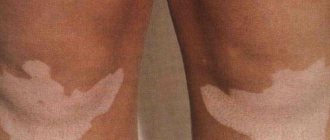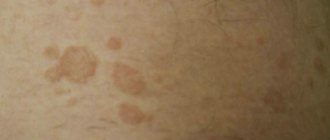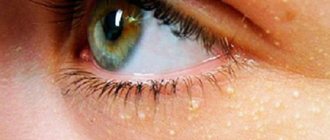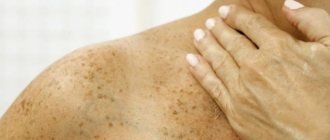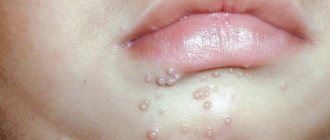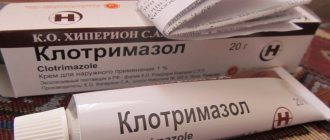A birthmark on the face is an area of skin that differs in color and structure from the surrounding skin. Such age spots usually do not pose a risk to human health, but in some cases there is a risk of developing melanoma. In addition, a birthmark, especially on the face, spoils the appearance and creates a certain psychological discomfort for a person. How to remove education? Let's consider what modern cosmetological methods will solve the problem and cope with an unpleasant visual defect.
Kinds
Birthmarks on the face appear on the skin due to improper development of tissue in places where cells accumulate, which produce a certain pigment - melanin. Formations of this type can be either congenital or appear throughout a person’s life due to hormonal imbalances, hereditary characteristics, excess ultraviolet radiation, or after injury or illness. Let's look at the main types of stains.
Regular
Formations of a brown shade are flat or slightly protruding above the surface of the skin, often covered with hairs.
Such spots on the face, as a rule, do not cause trouble to a person in everyday life, but only on condition that they are not subject to frequent trauma.
Vascular
Pigment spots of this type occur due to the accumulation of capillaries and blood vessels, and therefore most often have a dark red or burgundy-brownish tint.
There are the following types of birthmarks:
- Hemangioma. A red spot that appears in the first months of a baby’s life and, gradually fading, disappears by 7–9 years. Despite the fact that this skin defect does not pose a threat to the child’s health, monitoring the condition of the neoplasm is still necessary.
- "Wine." At first, the birthmark is pink in color and has a flat surface, but over time it darkens and increases in size. In an adult, the formation may become bright red or purple, with a bumpy texture. The most common locations include the forehead and cheeks. The stain does not go away on its own; the removal method is selected by a specialist after a visual inspection.
- "Salmon" This phenomenon is very common because it occurs in newborns. An orange or red birthmark may appear on the back of the head, neck, or temples and is usually associated with compression of blood vessels during childbirth. Salmon spots do not require treatment and go away on their own by the time the child is one year old.
Even if the birthmark remains unchanged for many years, its appearance must be constantly monitored. If the structure, color or size of the nevus changes, you should definitely contact a dermatologist.
Folk recipes
Since ancient times, there have been folk techniques with which healers removed small red birthmarks. To do this, they recommended using effective recipes and lubricating the formations:
- bee propolis;
- castor oil;
- juice of garlic or onions;
- potato mush;
- dandelion leaf juice.
https://www.youtube.com/watch?v=z35yqKT4hM8
Some methods actually helped reduce the size of the birthmark or even get rid of it completely. The main effect was achieved due to the whitening effect of these ingredients. However, if the growth continues to increase in size, it is necessary to seek medical help and not self-medicate the red birthmark. The value of professional therapy is much more important than witchcraft knowledge.
Indications for removal
Many people, especially at a young age, with nevi (especially in the face or on open areas of the body), try to get rid of them faster. However, oncologists and dermatologists do not recommend removing birthmarks without medical indications, since due to the intervention in the structure of the formation, a “reverse reaction” may occur, for example, excessive growth of damaged tissues or their degeneration into a malignant tumor.
Removal of birthmarks on the face is indicated in the following cases:
- The location of the formation causes frequent damage and causes discomfort to the person.
- The spot increased in size and painful sensations appeared.
- The shape or color of the defect has changed.
- Crusts, peeling, and bleeding appeared.
The issue of removing a birthmark on the face must be approached very responsibly.
An experienced dermatologist will determine the type of tumor and tell you whether it can be removed or not, and will also recommend the most effective method for each specific case.
Mole on the chin
A strong, self-confident person, accustomed to achieving his goals - this is what can be said about a person with a nevus on his chin. Women with a birthmark in this place are romantic and sensual, reliable and sensible, and men are the real support of the family. Regardless of the gender of a person marked with a mole on the chin, he is characterized by a dislike of change; such people are conservative and do not like novelty too much, for fear of losing face in the dirt.
They are hospitable hosts, their house is warm, cozy and always full of guests. However, there are also disadvantages to a mole on the chin - its owners are powerful and stubborn, and this can frighten those who are not yet accustomed to their strong character. A woman with a birthmark on her chin will not allow her husband or anyone else to decide anything for herself; she will push through her opinion. “There are two opinions - the wrong one and mine” - this is definitely about her.
A mole on the chin is a sign of a person who will stop at nothing on the way to his goal. Women with this mark equally easily manage both their own family and a large company with many employees, without ever losing face. They do not like manipulation, preferring to resolve issues without unnecessary floridness.
Clusters of moles on the face can also be important. If the spots form a figure without corners, that is, a circle or oval, this is a good omen; oddly enough, this also includes a triangle. A square or star from moles, on the contrary, can warn of future difficulties in life. In any case, no matter where the mole is, no matter how it is located, its voice is nothing more than advisory. Ultimately, a person creates his own destiny.
We suggest you find out how long it takes for menstruation to start after a vacuum
Types of procedures
Sometimes you can get rid of a birthmark by taking corticosteroids, but in most cases more effective and modern methods are used. They differ in duration, degree of trauma, and the ability to be used for specific types of skin imperfections. During some procedures, anesthesia is required: an anesthetic gel or an anesthetic injection.
Let's consider what methods can be used to remove a birthmark on the face:
- With a radio knife. Cauterization of the defect occurs using a special electrode, which heats and evaporates the skin in the desired location. Radio waves do not affect the deep layers of the dermis. This removal method is considered quite effective and gentle, leaving no marks on the skin.
- Surgical. Excision is performed in cases where the birthmark is large. It is removed along with the surrounding tissue. The operation is performed under local anesthesia, in children - under general anesthesia. After the procedure, the wound should be treated with antiseptics and antibiotics. If necessary, an element of the affected tissue is sent for examination. The surgical method is rarely used to remove spots on the face, since the operation leaves a scar on the skin.
- Laser. The most popular method of getting rid of spots on the face, eliminating the formation of scars. An area of skin is treated with point pulses from a special device – a vascular laser. The rays act specifically and only affect the affected tissue. The procedure is painless, lasts only a few minutes and has no complications. To remove several stains, one session is sufficient. Using the technique, you can even forget about “wine-wine” birthmarks.
- Cryodestruction. The stain is removed by exposure to liquid nitrogen at low temperatures. The damaged area of skin hardens, after which the cosmetologist removes this layer. This method does not allow you to get rid of the defect in one procedure, since the action of nitrogen occurs in stages. In addition, a specialist cannot always accurately determine the depth of exposure of the substance to the skin. The consequences of the session may be a thermal burn or a scar at the treatment site. Despite its low cost, the cryodestruction procedure is not very popular.
- Electrocoagulation. The method involves thermal exposure of the birthmark to high-frequency current. Using an electric discharge, unnecessary tissue is cut off. After the procedure, a burn remains, which quickly passes. This method is quite cheap and effective, so it is in demand in cosmetic clinics.
You should not trust dubious sources that report the possibility of independently and safely eliminating the defect. Such methods will not help cope with the problem, but can cause great harm. With unprofessional physical or chemical exposure, there is a high probability that uncontrolled growth of tumor tissue will begin.
What happens if you rip off a mole?
You cannot remove a nevus yourself.
Firstly, it is dangerous, and secondly, it is simply ineffective. If the mole is located close to blood vessels, prolonged bleeding may develop. Often such self-medication leads to re-formation of the nevus, its growth or malignancy.
We suggest you read How to get rid of spots on your face at home
Therefore, it is difficult to predict what will happen if a mole is torn off. It may have no consequences, or it may cause serious complications for the health and life of patients.
Doctors warn that any trauma to the nevus is extremely undesirable, but pedunculated moles or small convex formations can be accidentally removed with nails or hard items of clothing.
What to do if you rip off a mole:
- cauterize the wound with an alcohol solution;
- stop the bleeding by applying a gauze bandage;
- come to see a specialist.
In cases of partial removal of a mole, do not touch the remaining formation, do not cut it off or tear it off.
If a white spot is noticed around a mole, only a dermatologist can determine this. However, if you have a mole with a white halo, this may mean that the neoplasm has begun to degenerate into melanoma, which must be prevented as soon as possible.
Sometimes such pigmentation appears before the disappearance of the mole (as a sign of depigmentation), and in other cases it may signal its degeneration. White spots around the mole appear as a characteristic sign of Setton's nevus. This formation is considered harmless in terms of degeneration into a more malignant form, however, melonomas (aggressive cancerous formations) can also have such a white rim, so the appearance of white spots is a reason to contact a medical specialist.
Contraindications
Not everyone can remove a birthmark on the forehead, nose, cheek or chin. There are restrictions to the procedure:
- Cardiovascular pathologies.
- Colds.
- Pregnancy.
- Chronic diseases in the acute stage.
- Neurological diseases.
Be careful when removing large stains. Permission for this procedure is given only by an oncologist after examining the affected tissues for the presence of malignant changes.
It is also not always justified to remove birthmarks in children under 16 years of age. If there is no urgent need, it is better to postpone the procedure until the child reaches adulthood.
Prerequisites for mole removal
Indications for removal of nevi are:
- Traumatic damage to a mole.
- Changing shape, size. If a mole grows on your face, then this is a reason to consult a doctor for advice.
- Feeling of discomfort due to the location of the mole.
- The appearance of pain in the area of the mole, peeling, itching.
- Hair loss on a mole.
- Moles on the face of men are constantly exposed to mechanical stress due to shaving, which causes microtrauma and the risk of degeneration.
If a mole on a woman’s face grows during pregnancy, there is no need to worry - this is a physiological process. Trauma can also be the cause of nevus growth. If the color of the mole changes along with its growth, you should urgently contact an oncologist for examination.
Important! Moles on the face that change need to be removed as soon as possible to stop the process at an early stage.
The following factors will be contraindications: exacerbation of a chronic disease and acute infectious disease. If a mole on the face is inflamed, it cannot be removed until the process has completely subsided.
Prevention
To prevent the tumor from degenerating into melanoma, you must follow the following recommendations:
- Try not to injure the birthmark. If this happens, you should definitely contact a specialist for an inspection.
- Avoid visiting the solarium.
- Do not sunbathe in the sun if you have a large number of moles and birthmarks.
- Use special products with a high degree of protection against UV rays.
- Avoid contact of birthmarks with chemicals.
Problem areas should be regularly inspected for changes in color and shape. At the slightest suspicion, consult a doctor immediately.
What are moles
Moles are benign pigmented formations on the skin that can be of different colors - red, purple, brown, even black. They can be flat, that is, located at the level of the skin, or rise above it. These formations appear due to the fact that the cells first accumulate pigment and then turn into melanocytes. Their accumulation is what the mole eats.
Why do moles appear on the face? First of all, this occurs due to excessive ultraviolet irradiation and neglect of protective equipment.
Note. Also, new moles on the face of women often appear during and after pregnancy, which is associated with hormonal changes. A hereditary predisposition to the appearance of one or another number of moles cannot be ruled out.
Possible consequences
If you have moles on your face, you should not overexpose yourself to the sun or use artificial tanning.
Corticosteroids may sometimes be used to limit the growth of these lesions. They do not remove moles, but they can inhibit their growth. These hormonal drugs are taken orally or, if they are in the form of a gel, applied to the formations.
How to care for the wound after surgery depends on which method of removal was used. Recommendations are given by the doctor who performed the operation. General rules: do not wet the wound, do not use cosmetics, do not peel off the crust that has formed. Avoid being in direct sunlight for 7–10 days.
Children may develop birthmarks from birth or after a couple of months. Nevi in young children are often harmless, but it is better to have them examined and, if possible, removed. If your child has pigmentation with a slight bulge, it is better to tell the dermatologist about it. Such formations are called vascular nevus and can be dangerous for the child.
Sometimes it is worth removing large moles as early as possible, especially if there is a danger of their degeneration. There are no age restrictions. Nevi in infancy are removed in the same ways as for adults. Getting rid of tumors and pain relief during surgery is no different. The only problem is the risk of a keloid scar, which will have to be removed with plastic surgery.
After removing a birthmark, negative consequences are possible. The first thing that may bother you is pain. They appear after surgery and last up to several days. Painkillers will help get rid of this problem. A serious consequence of removal may be the risk that pigmentation will reappear. Another unpleasant risk is infection. Therefore, it is important to do these procedures in certified medical institutions.
Most often, little babies are born with clear skin without moles. But sometimes the following formations may appear on their skin:
- specific salmon-colored spots. Such formations are not voluminous; most often they form on the bridge of the nose, cheekbones or temporal part of the newborn;
- hemangioma. This formation may appear in the first month of the baby’s life. Hemangioma usually has a red tint and resolves quickly. Most often, this spot disappears by the end of the baby's first year of life;
- wine points. This birthmark consists of a small network of small and thin vessels on the surface. It can be located on any part of the body, and it can only be removed using a laser or radio wave method.
- "flaming birthmark." In this case, pigmentation affects the subcutaneous layer of the epidermis. This neoplasm grows quickly with the child. If it starts to hurt or bleed, you should consult a doctor.
We invite you to familiarize yourself with Relief ointment for wrinkles - Life without wrinkles
Laser removal
How to get rid of a birthmark? Use the laser. The method is so widely used due to its compelling advantages:
- painlessness. Due to the high temperature and targeted impact, healthy subcutaneous tissue is not affected. Therefore, the discomfort from the session is minimal. Dermatologists do not practice using anesthesia, but for children, pregnant women and people with increased sensitivity of the dermis, lidocaine spray or other local analgesics are applied to the area where surgery is planned;
- high efficiency. After exposure to the device, no trace of a cosmetic defect remains on the surface. Accumulations of melanin are completely removed. This means that there is no risk of tumor degeneration, relapse or rapid growth;
- rapidity. The entire manipulation takes about 20 minutes;
- no complications. After exposure to the laser, there is no bleeding (if the vessels are damaged, they are immediately sealed), suppuration and inflammation (high temperature exposure destroys any harmful bacteria and viruses);
- smooth surface. If the manipulation and recovery process are carried out correctly, there will be no scars or keloids left in place.
Principles of treatment
Birthmark removal is a procedure that is performed in cosmetology clinics or under the supervision of an oncology doctor. The choice of a specialist depends on the reason that caused the formation of the spot. Trying to cope with the problem on your own is life-threatening. A birthmark should be removed in the following cases:
- the nevus is located in such a way that it interferes;
- exposed to frequent injuries;
- the spot began to hurt and grow;
- take on a different shape and shape.
There are practically no contraindications for why one cannot get rid of a birthmark. The only restrictions are exacerbations of colds and heart problems. If it is large, or there have been global changes in its appearance, then it can only be removed by an oncologist. He will take a sample to rule out malignant cell growth.
Depending on the location of the birthmark, its nature, and characteristics, various methods are used with which you can get rid of the problem forever.
Cryodestruction
Exposure to nitrogen is one of the popular cosmetic procedures
Here it is important to take into account the depth and volume of the birthmark and its location. The specialist points a tube with liquid nitrogen at the spot, the blood vessel freezes, and the skin burns
The birthmark disappears by exfoliation, which helps to remove it. This way, it is possible to get rid of the stain for those who have a birthmark on their cheekbones or forehead, but there is a danger of a scar.
Electrocoagulation method
Allows you to get rid of stains using high frequency current forever. First, a wound appears, then it becomes overgrown with a crust, which falls off. The value of the method in a more gentle mode.
Laser exposure
If there are complaints about an aesthetically unsightly appearance, then laser removal is suitable. There will be practically no traces left, however, the price of this procedure increases. It is done only in aesthetic cosmetology clinics.
Excision by radio waves
With this method, cancer treatment clinics will help you remove it, regardless of the nature of the birthmark. Radiosurgery is safe, does not leave scars, and is indicated at any age. Its value is priceless, as it removes stains of any nature.
Surgeon's scalpel
In cases where there are many spots, but the deeper layers of the epidermis are involved, surgical removal is performed. It consists of several stages.
- Skin preparation and anesthesia.
- Removal with a scalpel along with the epithelium.
- Closing the wound with sutures.
After a week they are removed, leaving a slightly noticeable mark. This procedure is not suitable for many people and is performed where the seam will not be visible.
If there is a suspicion that the resulting spot is skin cancer, then the place where it appeared is excised, and the tissue is sent for histology. Based on its results, the question of how to get rid of the tumor and what method to choose is decided. Most likely, they will offer radical excision and subsequent oncological treatment.
Possible consequences of deletion
The main risk associated with operations to remove moles on the face is the malignant degeneration of the remaining melanocytes, which are not always possible to remove completely. This is why it is so important to examine moles that are bothering you. Only a competent doctor will be able to correctly examine problem areas of the skin and develop treatment tactics. Before any medical intervention, it is necessary to check your health to minimize the risks of complications and find out whether moles on the face can be removed.
Often, after mole removal, scars remain on the face. This occurs due to an incorrectly chosen treatment method or improper execution of the procedure. If cryodestruction was performed, it is possible to get a burn, which can lead to the appearance of a scar.
This is what the skin looks like immediately after mole removal. The consequences for surrounding tissues are obvious.
Advice. The choice of a doctor who will suggest how to remove a mole from the face must be taken responsibly. You should not trust employees of beauty salons without the appropriate qualifications.
Is it necessary to remove birthmarks?
Many people live with a birthmark and even consider it their peculiarity. Remember that the stain is not always a harmless formation, as it initially seems. If the formation causes discomfort or interferes, you can remove it at your own request for cosmetic purposes. The decision to intervene is made only by a doctor, preferably an experienced one. Because there is a high risk of complications. But there are cases when there are direct indications for removal.
Today there are several methods for removing nevus. They are distinguished by the following characteristics: method of exposure, severity of pain and recovery time. The operation should be performed only by an experienced and competent doctor, preferably an oncologist. This is the only way to be sure that the removed nevus will not cause the development of melanoma - skin cancer.
Removal methods
For moles that have pronounced signs of malignancy, the choice of methods is small. Most often they are removed surgically. There are more ways for “good” nevi. You can get rid of tumors using:
- laser;
- cryodestruction;
- electrocoagulation;
- radio wave exposure;
- folk methods.
Before removing a mole on the face, you should definitely contact a dermatologist-oncologist.
The doctor will examine the tumor and give permission for removal. If necessary, he can also select a suitable method. You should not completely trust beauty salons - they are not always equipped with the necessary equipment, and their employees often do not have sufficient knowledge.
Surgical removal
On the face, they try to resort to surgical removal only in extreme cases, when the tumor threatens the patient’s life. Large scars often remain on the skin, so the procedure is not worthwhile for cosmetic purposes.
The mark is cut out along with part of the healthy skin to ensure that no aggressive cells remain. This is one of the most reliable methods; relapses are practically excluded. After the nevus is removed, the wound is treated, cauterized, and an antibiotic bandage or stitches are applied. The recovery period takes quite a long time.
The method is suitable even for large moles. The procedure has virtually no contraindications, with only one being intolerance to anesthetics.
Laser removal
One of the most preferred methods for removing moles on the face if the neoplasm turns out to be “good”. The procedure is bloodless. The patient does not experience pain during removal; it is performed under local anesthesia. The laser is aimed directly at the mole. The beam burns out a small point without damaging healthy tissue. After removal, a small crust appears at the site of the tumor, which comes off in 5-7 days.
Scars are not typical for this method. Only a light spot may form, but over time it will acquire a normal shade. If it is important to you that there are no marks left on your face, take a closer look at this method.
The video shows the process of removing a small nevus on the forehead. Please note that the entire procedure takes 2-3 minutes.
There are relatively few contraindications to the procedure. Laser treatment should be avoided:
- in case of degeneration of the mark into a malignant tumor;
- pregnant women;
- people with allergies to ultraviolet radiation;
- with exacerbation of herpes;
- with menstruation on the day of surgery;
- inflammatory diseases.
You may be interested in: In what cases is it necessary to remove a mole with a laser?
Radio wave method
Also a great way to get rid of a mole on your face. It will help remove small marks without leaving a trace. If the formation was large, a scar of the same size or slightly smaller may remain.
Psychologically, this procedure is a little easier to endure than laser manipulation. The tissues are not cauterized here, but are removed using high-frequency radio waves. The operation takes a few seconds; you simply won’t have time to feel anything. The method is safe, suitable for nevi of any size and allows you to take material for subsequent research. The wound heals in about a week.
In the video, a nevus is removed using a radio knife. A large tumor requires several movements, but a specialist can cut off a small point with one.
This method is not recommended to be used:
- during pregnancy or lactation;
- for diabetes mellitus;
- when wearing pacemakers.
Electrocoagulation
After electrocoagulation, a barely noticeable scar may remain at the site of the mole. For marks on the face, it is worth choosing if a laser and radio knife are not suitable for you for some reason. The method involves exposing the tumor to electric current. The marks are burned under local anesthesia; the patient does not feel pain. During the procedure, healthy tissues are cauterized and this avoids bleeding or infections entering the wound. The crust goes away after surgery in 7-10 days. Of the contraindications:
- intolerance to electrical procedures and anesthesia;
- problems with blood clotting.
Cryodestruction
During cryodestruction, pigmented spots are frozen with liquid nitrogen. It is less intimidating than previous methods and is painless. Immediately after surgery, the moles remain in place, protecting the wound from infection. Within 2 weeks, the tumors disappear, leaving healthy skin. After removing a nevus on your face, you will have to take a vacation or tolerate this cosmetic defect for a while.
If it is psychologically difficult for you to endure procedures where the skin is exposed to high temperatures or electric current, this is the optimal method. Only on the face cryodestruction should be carried out with caution. Be sure to read reviews about the specialist you are contacting and look at his work. Nitrogen cannot be directed in the same way as a laser or radio knife; it often freezes healthy skin and leaves scars. The method also has a relatively high risk of relapse; sometimes it is necessary to repeat the procedure. Allergy to cold is a contraindication to the use of the method.
Home methods
It is better not to experiment with mole removal at home. Independent manipulation of tumors is dangerous. But if you decide to try non-medical methods at your own risk, it is still important to have your spots examined by a dermatologist first.
Most often, “Super cleanser” is used to remove nevi on your own. The method is very budget-friendly - in the pharmacy the liquid costs up to 100 rubles. To carry out the procedure, the skin is treated with an antiseptic, and a healing ointment is applied around the mark. Celandine is dripped directly onto the mole. It cauterizes the damaged tissue, leaving a crust and a wound at the site of formation, which gradually heals.
It is better not to use Super Clean on the face. There is a high chance that you will damage healthy skin. There is also a risk that the manipulation will not remove the nevus completely and a new one will appear in its place.



